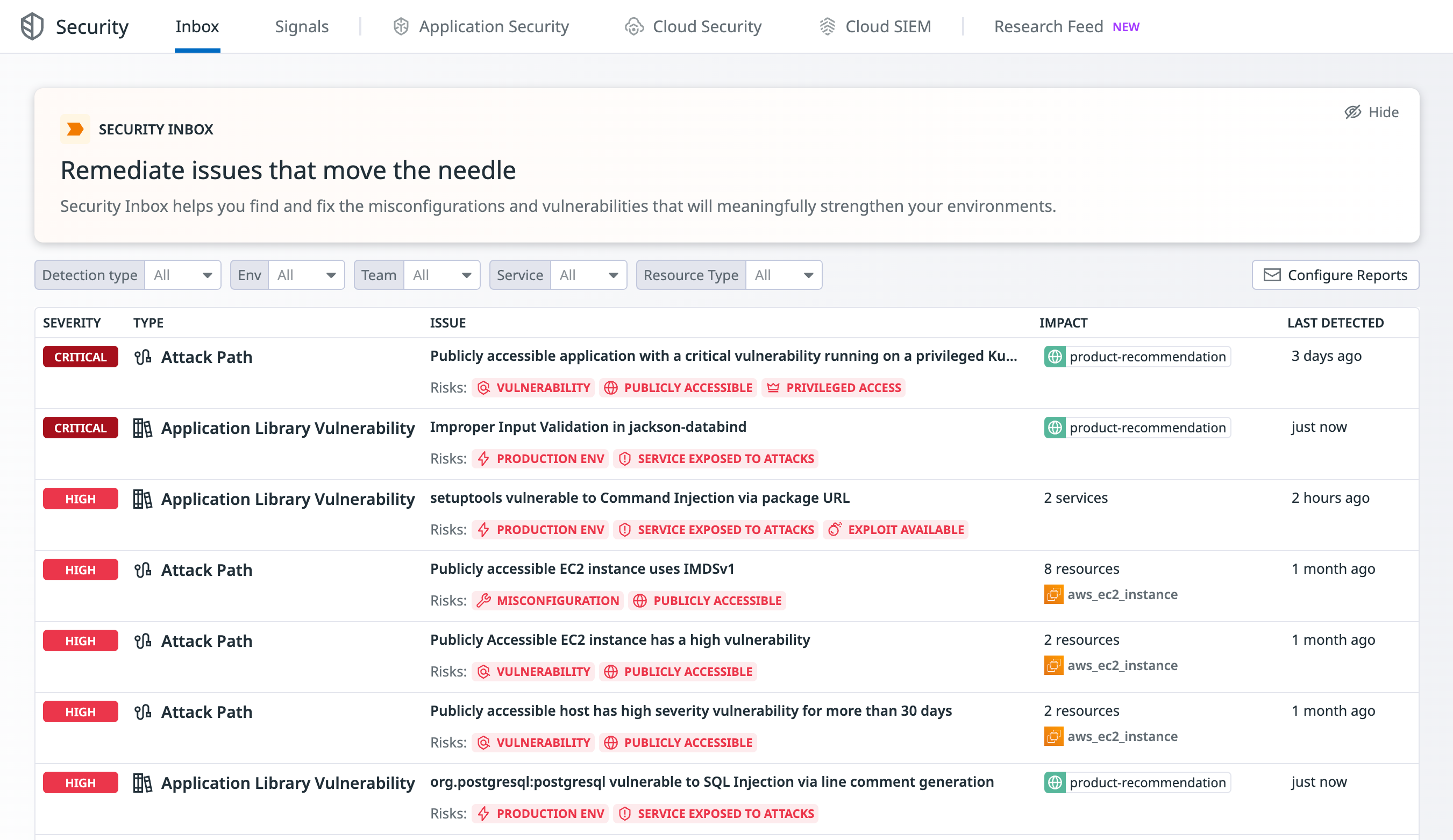- 重要な情報
- はじめに
- Datadog
- Datadog サイト
- DevSecOps
- AWS Lambda のサーバーレス
- エージェント
- インテグレーション
- コンテナ
- ダッシュボード
- アラート設定
- ログ管理
- トレーシング
- プロファイラー
- タグ
- API
- Service Catalog
- Session Replay
- Continuous Testing
- Synthetic モニタリング
- Incident Management
- Database Monitoring
- Cloud Security Management
- Cloud SIEM
- Application Security Management
- Workflow Automation
- CI Visibility
- Test Visibility
- Intelligent Test Runner
- Code Analysis
- Learning Center
- Support
- 用語集
- Standard Attributes
- ガイド
- インテグレーション
- エージェント
- OpenTelemetry
- 開発者
- 認可
- DogStatsD
- カスタムチェック
- インテグレーション
- Create an Agent-based Integration
- Create an API Integration
- Create a Log Pipeline
- Integration Assets Reference
- Build a Marketplace Offering
- Create a Tile
- Create an Integration Dashboard
- Create a Recommended Monitor
- Create a Cloud SIEM Detection Rule
- OAuth for Integrations
- Install Agent Integration Developer Tool
- サービスのチェック
- IDE インテグレーション
- コミュニティ
- ガイド
- API
- モバイルアプリケーション
- CoScreen
- Cloudcraft
- アプリ内
- Service Management
- インフラストラクチャー
- アプリケーションパフォーマンス
- APM
- Continuous Profiler
- データベース モニタリング
- Data Streams Monitoring
- Data Jobs Monitoring
- Digital Experience
- Software Delivery
- CI Visibility (CI/CDの可視化)
- CD Visibility
- Test Visibility
- Intelligent Test Runner
- Code Analysis
- Quality Gates
- DORA Metrics
- セキュリティ
- セキュリティの概要
- Cloud SIEM
- クラウド セキュリティ マネジメント
- Application Security Management
- AI Observability
- ログ管理
- Observability Pipelines(観測データの制御)
- ログ管理
- 管理
Security Inbox
このページは日本語には対応しておりません。随時翻訳に取り組んでいます。翻訳に関してご質問やご意見ございましたら、お気軽にご連絡ください。
Security Inbox provides a consolidated, actionable list of your most important security findings. It automatically contextualizes and correlates insights from Datadog security products across vulnerabilities, signals, misconfigurations, and identity risks into a unified, prioritized view of actions to take to strengthen your environment.
Types of findings in Security Inbox
The findings that appear in Security Inbox are generated from Application Security Management (ASM) and Cloud Security Management (CSM). By default, these include the following types of findings:
- A curated set of misconfigurations for CSM Misconfigurations, compiled by Datadog Security Research.
- A curated set of identity risks for CSM Identity Risks, compiled by Datadog Security Research.
- Application library vulnerabilities for Software Composition Analysis(SCA). All high and critical application library vulnerabilities on production services under attack appear in the inbox.
- Application code vulnerabilities for Code Security vulnerabilities. All high and critical application code vulnerabilities appear in the inbox.
- Attack Paths. An attack path outlines a series of interconnected misconfigurations, container image, host, and application vulnerabilities that malicious actors could leverage to gain unauthorized access, escalate privileges, or compromise sensitive data in your cloud environment. All attack paths are listed in Security Inbox by default.
Security Inbox also takes the following detected risks into consideration when determining which findings appear in the inbox:
- Public accessibility: Publicly exposed resources carry elevated risk, especially if they contain vulnerabilities or misconfigurations. To learn more, see How Datadog Determines if Resources are Publicly Accessible.
- Privileged access: Resources with privileged access carry elevated risk as they grant elevated permissions that can expand the attack surface.
- Under attack: Resources that are seeing suspicious security activity carry elevated risks. Resources are flagged as “Under Attack” if a security signal has been detected on the resource in the last 15 days.
- Exploit available: Vulnerabilities with public exploits available carry elevated risks. The availability of a public exploit is verified with different exploit databases, such as cisa.gov, exploit-db.com, and nvd.nist.gov.
- In production: Vulnerabilities in production environments carry elevated risks. The environment is computed from the
envandenvironmenttags.
How Security Inbox prioritization works
Security Inbox ranks issues by considering the severity of a finding first, followed by the number of correlated risks, and then the number of impacted resources and services.
- Severity (Critical, High, Medium, and Low): Severity is determined by the Datadog Security Scoring Framework for cloud misconfigurations and identity risks, and by CVSS 3.1 for vulnerabilities.
- Number of detected risks: When two findings have the same severity, the one with a greater number of detected risks is given higher priority.
- Number of impacted resources and services: If two findings share both the same severity and the same number of detected risks, the finding that impacts a greater number of resources and services is prioritized higher.
Note: The type of finding, detected risk, or impacted resource does not influence prioritization.

